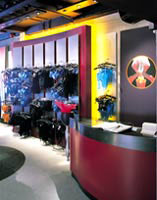Coming out of the closet
Sex is no longer a taboo subject for designers, as proven by Tom Dixon’s involvement in vibrator design and Joseph-style interiors for new retailer Myla.

Two questions for you. What is the difference between a vibrator and a “coffee-table”, design-led sex toy? And when does a sex shop become a “passion and fashion retailer”?
The fact these questions are being posed shows how far the sex shop revolution has come. In tune with the growing acceptance and accessibility of sex, stores are finally shaking off their reputations as seedy Soho basements and becoming multi-million pound, design-led enterprises.
Myla, which will open its doors in London in October, is harnessing design to elevate the brand above its rivals to a luxurious, exclusive marque. It has employed the services of high-profile designers Tom Dixon and Marc Newson to design a set of sex toys (DW 5 July).
“Design is everything to the brand and our customers,” says Myla co-founder Charlotte Semler. “Quality – aesthetically as well as in terms of manufacturing – is the most important aspect of Myla.”
The brand is aimed at fashionable, affluent women who shop on London’s Sloane Street rather than men in dirty macs scurrying around Soho with brown paper bags. It claims to be on the brink of “revolutionising women’s attitude to sex and shopping” with its mix of lingerie, sex toys and bodycare products.
Semler approached Dixon and Newson as “they are two of the greatest product designers in the world”, she says. They did not need much convincing. “Like all good designers, [they] relish any sort of challenge to overturn conventional wisdom,” she says.
Dixon and Newson combine modernity with sensuality in much of their work, which mirrors the Myla brand values, adds Semler. “Modernity tends to be associated with coldness, and sensuality with “backward, boudoirstyle” sex shops. Myla is a combination of both,” she says.
Semler and co-founder Nina Hampson decided to launch a luxury brand that happens to be a sex brand, rather than try to give a sex brand an upmarket edge. In this way, she says, it will be easier to establish Myla at the top end of the market.
“We aim to breathe new life into the entire concept of sex shops and sex toys,” she adds.
Myla’s range of sex toys – Semler eschews the word vibrator – embodies the spirit of the brand and its design-led, upmarket values. They are unconventional and high quality, and Dixon and Newson have lent a broader perspective to what constitutes a “traditional” vibrator.
So what is the difference between a vibrator and a design-led sex toy? “Sex toys do not have to be phallic,” says Semler. She says Dixon and Newson were given detailed research on female sexuality and its “complex, abstract nature” and they used this as a basis on which to stretch the concept of a sex toy.
Dixon and Newson, who declined interviews, together with sculptors Marie Ruth Oda and Tara Cottam have between them created a five-strong range of vibrators. Newson’s model, Mojo, joins Bone and Ring by Dixon, and details are still under wraps. Semler says she hopes to work with more designers in the future.
Similarly, Myla’s interiors, designed in-house, are closer to a Joseph store than a musky, boudoir-style shop, says Semler. “It will be light, airy and contemporary,” she adds. A location for the store has yet to be confirmed, as are plans for further stores, but there will be “no high street roll-out”, she says.
This approach contrasts with that of Ann Summers, which makes no secret of being a mainstream, high street retail brand. It is currently working with Silver & Co, MHG and Elektra Lighting on a far-reaching redesign of its core brand, which is rolling out to a selection of pilot stores in the autumn.
Details on the store interiors are under wraps, but they have been signed off by the board, according to Ann Summers new business and brand development executive Rebecca Franklin.
The store concept in London’s Brewer Street and Oxford Street, called Soho, may roll out to “trendy” cities such as New York in the future.
Elektra Lighting has illuminated these two Soho stores. It was briefed to reposition the core brand as “harder, more street and more sex-oriented” without alienating or intimidating its predominantly female audience, according to Elektra Lighting designer Neil Knowles.
It created bright, but not overpowering, entrances, lighting the in-store merchandise well with no light in surrounding areas. This was to allow customers to focus on the products and let them feel more secure and less conspicuous among shadows.
Menacing, ambient lighting was introduced towards the rear of the stores where the bondage products and sex toys are displayed. Elektra Lighting projected light through bars and cages to create harsh “vaguely threatening” prison bar-style shadows on the floor.
The changing rooms feature subdued lighting to echo the circumstances in which the clothing – mainly bondage gear and lingerie – would be worn. Silicone waist-high pendant lights hang in each changing room, designed to be highly tactile and reflect the material of both breast implants and vibrators.
The look is fun, but ultimately accessible. Franklin says there is a danger in sex shops becoming too overbearing for consumers – a combination of overtly design-led, intimidating interiors and the fact it does, after all, sell sex toys and erotica.
And the difference between a sex shop and a “passion and fashion retailer”? The sticking point is the percentage of hardcore sex products sold, clarifies an Ann Summers spokeswoman. “Ann Summers only sells a small percentage of sex toys compared with lingerie,” she adds.
So it’s over to Myla for the toys. Philippe Starck vibrator, anyone?
-
Post a comment



